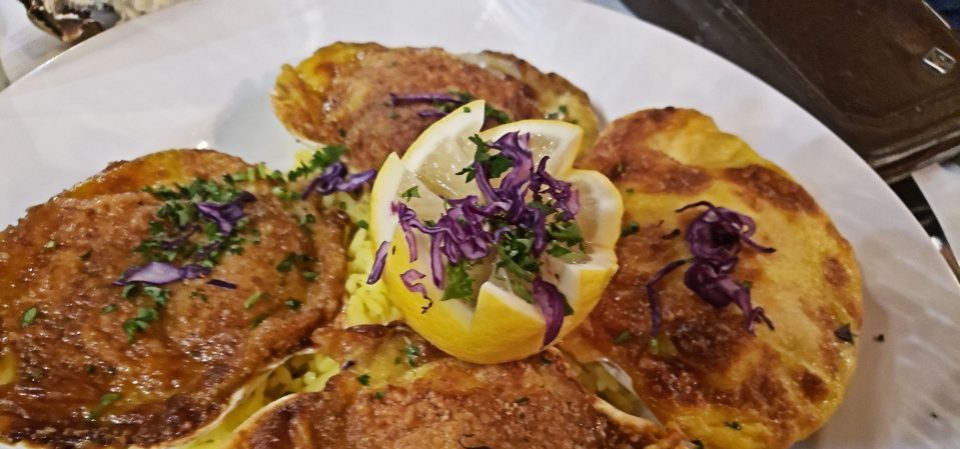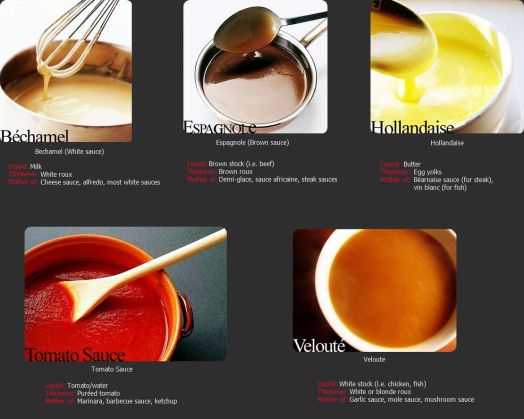I have had several questions in the past several weeks to please explain the 5 Mother Sauces. Mostly my reference is from The Sauce Bible – Guide to the Saucier’s Craft by David Paul Larousse. The book goes into some deep detail about the sauces – their origins and uses. It is well worth adding to your library, although it can be expensive. Other sources come from around the internet.
The history of the sauces starts back with the Greeks where Mithaecus in the 5th Century B.C. compiled the treatises the Art of Cooking. Little more survived a catastrophic fire that destroyed the library in Alexandria. Athenaeus of Naucratis, in the 3rd Century B.C., published his “… eating habits of different nations and his philosophies of gastronomy.” [The Sauce Bible]
80 B.C. the Romans enter the scene with Marcus Gavius Apicius. He was best known for extravagant meals, of which he spent enormous sums of money. The gastronomic Bible called The Book of Apicius – incidentally not written by Apicius, but rather by an unknown source – consisted of ten different volumes and influenced the cooking style of the European Chefs well into the 17th century.
Charlemagne (Charles the Great and Charles I), known as the Lord of the Table, brought some refinements to the cooking table. He added a variety of spices and some table manners to the history, but few gastronomic changes. He was the first to invite women to the table, providing they did not wear “…noxious perfumes”.
The word sauce, from the Latin salsus and the past participle of sallere meaning to salt, was used to refine a dish and to marinate foods.
Charlemagne introduced a thin slice of bread called a “trencher” to the table and it was supplied with the dinner to soak up the fats and juices. A dodine was a type of sauce used in medieval times. There were three classifications of this: (1) White dodine, milk boiled with ginger, egg yolks and sugar. (2) Red dodine, toasted bread soaked in red wine, rubbed through the sieve and then boiled with fried onions, bacon, cinnamon, nutmeg, cloves, sugar and salt. (3) Verjuice dodine, raw grape juice, egg yolks, crushed chicken livers, ginger, parsley and stock.
Three other well known people then developed and refined Charlemagne’s “sauces”. Catherine de Medici added an Italian influence, Francois Pierre La Varenne and Antoine Careme added the French influences. But probably the most influential person in the modern segment of this history was Auguste Escoffier.
Whereas Careme was the first to classify sauces into four groups, Espagnole, Allemande, Veloute and Bechamel, Escoffier named the following – and as pictured above – the foundation or mother sauces. Espagnole, Bechamel, Hollandaise, Veloute and Tomate.
In David Paul Larousse book, there are about 335 pages of sauces that are all derived from these fives basic sauces. If you master these five, you will be well on your way to making some interesting and fantastic meals for your table. Here is a link to The 5 French Mother Sauces and Their Uses. Here are the recipes for the 5 Mother Sauces. These are the traditional recipes, so don’t be surprised at the ingredients. Be sure to Left-Click the graphic above to see enlarged. There are some good companion entrees for these sauces there. Enjoy!
1. Bechamel
Ingredients
5 tablespoons butter
4 tablespoons all-purpose flour
4 cups milk
2 teaspoons salt
1/2 teaspoon freshly grated nutmeg
Directions:
In a medium saucepan, heat the butter over medium-low heat until melted. Add the flour and stir until smooth. Over medium heat, cook until the mixture turns a light, golden sandy color, about 6 to 7 minutes.
Meanwhile, heat the milk in a separate pan until just about to boil. Add the hot milk to the butter mixture 1 cup at a time, whisking continuously until very smooth. Bring to a boil. Cook 10 minutes, stirring constantly, then remove from heat. Season with salt and nutmeg, and set aside until ready to use.
2. Espagnole Sauce (Brown Sauce)
Ingredients:
1 cup onions, diced
½ cup carrots, diced
½ cup celery, diced
2 Tbsp clarified butter
2 Tbsp all-purpose flour
6 cups brown stock
¼ cup tomato purée
——– For Sachet: ——–
1 bay leaf
½ tsp dried thyme
3-4 fresh parsley stems
Preparation:
In a heavy-bottomed saucepan, melt the butter over a medium heat until it becomes frothy.
Add the mirepoix and sauté for a few minutes until it’s lightly browned. Don’t let it burn, though.
With a wooden spoon, stir the flour into the mirepoix a little bit at a time, until it is fully incorporated and forms a thick paste or roux. Lower the heat and cook the roux for another five minutes or so, until it’s light brown. Don’t let it burn! The roux will have a slightly nutty aroma at this point.
Using a wire whisk, slowly add the stock and tomato purée to the roux, whisking vigorously to make sure it’s free of lumps.
Bring to a boil, lower heat, add the sachet and simmer for about 50 minutes or until the total volume has reduced by about one-third, stirring frequently to make sure the sauce doesn’t scorch at the bottom of the pan. Use a ladle to skim off any impurities that rise to the surface.
Remove the sauce from the heat and retrieve the sachet. For an extra smooth consistency, carefully pour the sauce through a wire mesh strainer lined with a piece of cheesecloth.
Serve hot. If not serving the sauce right away, keep it covered and warm until you’re ready to use it.
Makes about 1 quart of Espagnole sauce.
3. Veloute (White Sauce)
Ingredients:
6 cups chicken stock
2 Tbsp clarified butter
2 Tbsp all-purpose flour
Preparation:
Heat the chicken stock to a simmer in a medium saucepan, then lower the heat so that the stock just stays hot.
Meanwhile, in a separate heavy-bottomed saucepan, melt the clarified butter over a medium heat until it becomes frothy. Take care not to let the butter turn brown, though — that’ll affect the flavor.
With a wooden spoon, stir the flour into the melted butter a little bit at a time, until it is fully incorporated into the butter, giving you a pale-yellow-colored paste. This paste is called a roux. Heat the roux for another few minutes or so, until it has turned a light blond color. Don’t let it get too dark.
Using a wire whisk, slowly add the hot chicken stock to the roux, whisking vigorously to make sure it’s free of lumps.
Simmer for about 30 minutes or until the total volume has reduced by about one-third, stirring frequently to make sure the sauce doesn’t scorch at the bottom of the pan. Use a ladle to skim off any impurities that rise to the surface.
The resulting sauce should be smooth and velvety. If it’s too thick, whisk in a bit more hot stock until it’s just thick enough to coat the back of a spoon.
Remove the sauce from the heat. For an extra smooth consistency, carefully pour the sauce through a wire mesh strainer lined with a piece of cheesecloth.
Keep the velouté covered until you’re ready to use it. Makes about 1 quart of chicken velouté sauce.
4. Hollandaise
Ingredients:
1 cup clarified butter (about 2½ sticks before clarifying)
4 egg yolks
2 Tbsp lemon juice (the juice from 1 small lemon)
1 Tbsp cold water
Kosher salt, to taste
Cayenne pepper (or a dash of Tabasco sauce), to taste
Preparation:
Heat an inch or two of water in a saucepan over a medium heat. Also, your clarified butter should be warm, but not hot.
Combine the egg yolks and the cold water in a glass or stainless steel bowl (not aluminum) whisk for a minute or two, until the mixture is light and foamy. Whisk in a couple of drops of lemon juice, too.
The water in the saucepan should have begun to simmer. Set the bowl directly atop the saucepan of simmering water. The water itself should not come in contact with the bottom of the bowl. Whisk the eggs for a minute or two, until they’re slightly thickened.
Remove the bowl from the heat and begin adding the melted butter slowly at first, a few drops at a time, while whisking constantly. If you add it too quickly, the emulsion will break.
Continue beating in the melted butter. As the sauce thickens, you can gradually increase the rate at which you add it, but at first, slower is better.
After you’ve added all the butter, whisk in the remaining lemon juice and season to taste with Kosher salt and cayenne pepper (or a dash of Tabasco sauce). The finished hollandaise sauce will have a smooth, firm consistency. If it’s too thick, you can adjust the consistency by whisking in a few drops of warm water.
It’s best to serve hollandaise right away. You can hold it for about an hour or so, provided you keep it warm. After two hours, though, you should toss it — both for quality and safety reasons. Makes 1 pint of Hollandaise sauce.
5. Tomate
Ingredients:
2 oz. salt pork, diced
2 cups onions, diced
1 cup carrots, diced
1 cup celery, diced
1 clove garlic, minced
2 28-oz. cans crushed tomatoes
1 quart veal or chicken stock
1 ham bone
Kosher salt, to taste
Sugar, to taste
——– For Sachet: ——–
1 bay leaf
½ tsp dried thyme
3-4 fresh parsley stems
8-10 black peppercorns, crushed
Preparation:
Preheat oven to 300°F.
Tie the sachet ingredients into a cheesecloth sack using a piece of kitchen twine.
In a heavy, oven-safe Dutch oven, render the salt pork over low heat until the fat liquefies.
Add the carrots, celery, onions and garlic and sauté for a few minutes until the onion is translucent but not brown.
Add the tomatoes, the ham bone, the stock and the sachet.
Bring to a boil, cover, and transfer the pot to the oven. Simmer in the oven, partially covered, for two hours.
Remove from oven. Remove sachet and ham bone and purée sauce in a blender or food processor until smooth, working in batches if necessary.
Season to taste with Kosher salt and a small amount of sugar — just enough to cut the acid edge of the tomatoes. Serve hot. If not serving the sauce right away, keep it covered and warm until you’re ready to use it.
Makes about 2 quarts of Tomate sauce.
For those of you who wanted to know, now you do. Enjoy!!!

